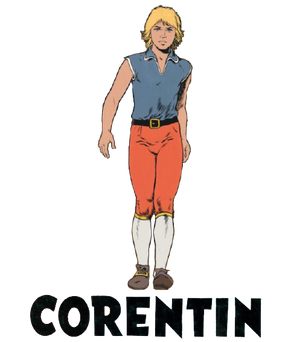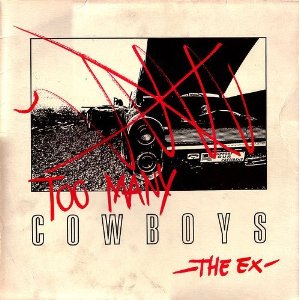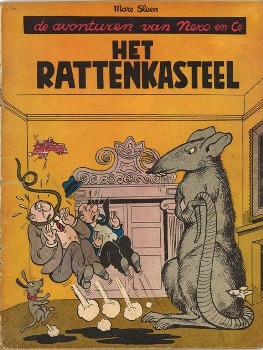
Spirou & Fantasio, commonly shortened to Spirou, is one of the most popular classic Franco-Belgian comics. The series, which has been running since 1938, shares many characteristics with other European humorous adventure comics like The Adventures of Tintin, Lucky Luke, and Asterix. It has been written and drawn by a succession of artists.

The Ex is an underground band from the Netherlands, started in 1979 at the height of the original punk explosion as a Dutch punk band. The Ex originated from the squatting movement in Amsterdam and Wormer, and was inspired by bands like The Fall and The Mekons.

Tom Puss is a Dutch comic strip, created by Marten Toonder. Together with Hans G. Kresse's Eric de Noorman and Pieter Kuhn's Kapitein Rob, it is regarded as the Big Three of Dutch comics.
A rat is a rodent of the genus Rattus. Colloquially, rat may refer to a muskrat, a medium-sized semiaquatic rodent native to North America.
Dutch comics are comics made in the Netherlands. In Dutch the most common designation for the whole art form is "strip", whereas the word "comic" is used for the (usually) soft cover American style comic book format and its derivatives, typically containing translated US superhero material. This use in colloquial Dutch of the adopted English word for that format can cause confusion in English language texts.

Le Petit Vingtième was the weekly youth supplement to the Belgian newspaper Le Vingtième Siècle from 1928 to 1940. The comics series The Adventures of Tintin first appeared in its pages.

Corentin is a series of comics created by Belgian artist Paul Cuvelier (1923–1978). Influenced by Robinson Crusoe, Cuvelier created the character of Corentin Feldoë in 1943. The character first appeared in a series of watercolors that Cuvelier made for his own family. Hergé, convinced of the merit of these watercolors, commissioned Cuvelier to do a series of comic strips. Thus, Corentin first made its appearance in Tintin magazine on September 26, 1946. Originally, the final story was published in 1974, four years before Cuvelier's death. 42 years later, a new album was published, written by Jean Van Hamme.
Jozef Van Hove, better known as Pom, was a Belgian comics writer and artist, mainly known for the humorous-satirical adventure comic strip Piet Pienter en Bert Bibber published in Gazet van Antwerpen. Pom was one of the best known Flemish comics authors of the 1950s. Between 1955 and 1995, 45 comic books were published of his newspaper comic strip. In 2010, a new album of Piet Pienter en Bert Bibber was created by Tom Bouden, with the collaboration of Luc Cromheecke, Dirk Stallaert, Steven Dupré, Martin Lodewijk, Marc Verhaegen, Willy Linthout, Jean-Pol, Steve Van Bael, Kim, Michael Vincent, Wim Swerts, Marc Legendre, Charel Cambré and Hec Leemans.
This is a timeline of significant events in comics prior to the 20th century.

Les Aventures des Schtroumpfs is a 1965 animated compilation film based on the Belgian comic book series The Smurfs. It was the first animated feature film featuring the Smurf characters. The film was released in 1965 in Belgium.

Pierre Fournier was a Canadian comic book writer, artist, editor, promoter and publisher. He was best known for his Michel Risque and Red Ketchup series which he co-created with his long-time friend Réal Godbout.

Too Many Cowboys is the second double-album Dutch anarchist punk band The Ex. Released in 1987, it mixes live and studio recordings and marks the band's beginning of a collaboration with British anarchist group Chumbawamba.

1936, The Spanish Revolution is an album of songs and archival photographs related to the Spanish Civil War, recorded and assembled by Dutch anarchist punk band The Ex. The band released it in 1986, the 50th anniversary of the Spanish Revolution, on their own label as a square 7" (17.5 cm) soft-cover book with two 45 rpm records. A 5" (12.5 cm) hardcover edition was republished by AK press in 1997, replacing the records with a pair of 3" CDs.
Juris Tjerk Emiles Ivars Vičs, "DR. RAT" was a graffiti artist from Amsterdam, Netherlands. Since his early years as a graffiti writer in the 1970s Ivar was tagging the name "DR. RAT" pioneering the movement in the Netherlands. He was a well known supporter of the association football club AFC Ajax, and would commonly tag "AJAKS" next to his name, misspelling it on purpose. He is largely considered the pioneer of the graffiti movement in the country, emerging out of the punk rock scene of the late 1970s.

Chlorophylle was a Belgian comics series and Raymond Macherot's best known work, alongside Sibylline. It is a fantasy comic about anthropomorphic forest animals, including the title character Chlorophylle, who is a dormouse.

Text comics or a text comic is a form of comics where the stories are told in captions below the images and without the use of speech balloons. It is the oldest form of comics and was especially dominant in European comics from the 19th century until the 1950s, after which it gradually lost popularity in favor of comics with speech balloons.

Het Rattenkasteel is a 1948 comic book album in the Belgian comics series The Adventures of Nero by Marc Sleen. It's the fourth album in the series and acclaimed as one of Sleen's best. In the 2000s the story was collected and re-published by the Flemish newspapers Het Belang van Limburg and Gazet van Antwerpen in a special series entitled "De beste 10 volgens Marc Sleen", where Sleen choose his ten favorite "Nero" stories. He placed "Het Rattenkasteel" first.
Celebrity comics are comics based on the fame and popularity of a celebrity. They are a byproduct of merchandising around a certain media star or franchise and have existed since the mass media and comics came into existence in the 19th century. Celebrity comics are usually not held in high esteem by critics, because of their purely commercial nature. They are solely created to capitalize on media trends and therefore published so quickly and cheaply that drawings and narratives tend to be of very low quality.

Blondin et Cirage is a Belgian humoristic adventure comic strip by Jijé created in 1939 for the Catholic children's magazine Petits Belges. The comic was also published in its Flemish counterpart Zonneland, initially under the name Wietje en Krol, later as Blondie en Blinkie. It stars two boys, Blondin – who is white – and Cirage – who is black.
Dutch Punk, or Nederpunk, is a body of music that evolved in the Netherlands that encompasses the various styles of punk rock music. The culture surrounding punk rock is often strongly politically oriented; in the Netherlands, punk culture grew alongside, and was influenced by, the Dutch squatters' movement and other European squatters' movements. Few Dutch punk bands write lyrics in Dutch. However, as a small country, punk in the Netherlands has evolved with a unique mix of UK, US, European, and global punk influences.












